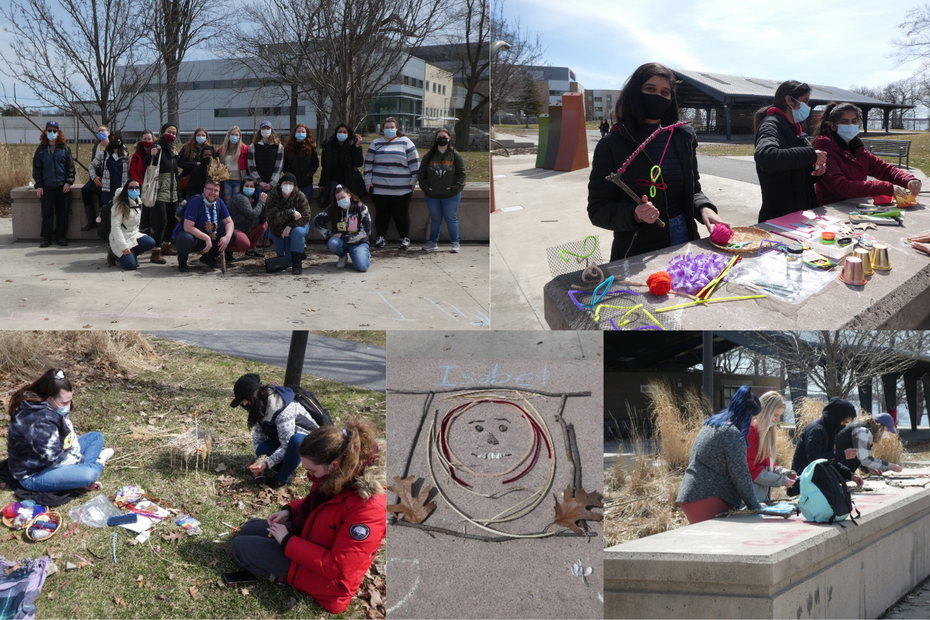Story submitted by Bonnie Dawson, Professor, Early Childhood Education
In a recent field trip to Lake Ontario Park, Early Childhood Education (ECE) students explored the use of basic art supplies combined with available natural materials to create art and storytelling activities for children outdoors. Working in small groups outside was a thrill after months online and the resulting activities were varied and engaging. The challenge of using materials “on hand” was met by the students with resourcefulness and creativity.
The experiential learning opportunity was part of the students’ Arts Based Curriculum 2 course, a second year ECE course that explores the arts as a medium to encourage communication, cooperation, celebration, and a sense of belonging in children and families in a childcare community.
Read the reflections written by ECE students about their experiential learning at Lake Ontario Park:
"For our outdoor art experience, we used sticks, shells, acorns, rocks, chalk, leaves and flower stems that we found on the ground to create this activity. We decided we were going to make portraits of ourselves using all natural materials. We explored the park as a group and found natural materials that would be perfect for the unique features of our bodies (straight hair, wavy hair, different coloured skin, hair, and eyes). We used branches to create a frame for our 'photos'. Everyone helped each other out with ideas on what do use for certain features. This activity was amazing; everyone had such unique art pieces and we all had fun doing it! It was so nice to have a group so that we could bounce ideas off each other. As the activity went on, there were more ideas flowing, like using leaves as hands to pretend the portrait is holding the frame or using bark to capture the curls in someone’s hair.
For extensions to the activity, we could steer into the children using natural materials to create other things like houses, hats, or necklaces. The children could further deepen their learning with these natural materials if we bring them into the classroom and use magnifying glasses and tweezers to look more closely at them." - Kirsten Kenny
"It was a great art activity because there wasn’t too much set up or clean up, everything was created from the natural materials around us. I think it was an exciting activity we created, we used natural materials to try and make a portrait of ourselves. It was also difficult, a good challenge, and it made us use our imagination to figure out what different materials we would use." - Emma Brown
"It was a beautiful sunny day. I was so excited thinking about meeting my classmates and teacher. As a student who spent all of my college life in front of a laptop due to the pandemic, it was a very meaningful opportunity for me to meet peers in person and do an activity together. We had a chance to create art with natural materials and art materials provided. We grouped freely and were able to explore the open-ended materials using our imagination and sharing ideas to create an art activity for young children. My group made a house for three little pigs with sticks, reeds and pipe cleaners, and I was happy that it turned out very well. As ECEs, our role is to encourage the children to be creative and expand their imaginations. This outdoor experience allowed us to go back to our childhood again and access our 'inner children'. I got so much inspiration from the outdoor experience that I can implement with my little friends at placement!" - Kyungah Choi
"We had such a sense of belonging and collaboration amongst all of us when we got to finally get out and meet each other (our fellow educators) and our teacher Bonnie Dawson. It was a beautiful spring day to get together at Lake Ontario Park. We were creating art using natural materials. These art materials are open-ended, meaning they can be used in an infinite number of ways or possibilities. We were setting up outdoor art activities that we could use with young children. It was inspiring to see all of our creative juices flowing and coming out in many artistic ways. Each group had a different idea that they created. I went to some of the other groups to see what they had come up with and I was so inspired and filed away some ideas that I could use with children in the future. It was crisp out, but it was rejuvenating at the same time, getting some fresh air and being creative with my colleagues/classmates.
I learned about where St. Lawrence College is located on the land when we had a land acknowledgment at the beginning of our outdoor class. I also learned there is an Indigenous Garden at Lake Ontario Park to honour Alderville First Nation. I am eager to go back and take a look to admire the flowers and plants that are native to this area in the Indigenous Garden someday soon." - Megan Smith
